Business Transactions: Formulation of Financial Statements and Accounts
VerifiedAdded on 2022/12/27
|17
|2472
|97
AI Summary
This document discusses the formulation of various financial statements and business accounts in the context of business transactions. It covers topics such as the preparation of journal entries, balancing of accounts, trial balance, income statement, and financial statements. Additionally, it explores the analysis of ratios and compares them with competitors to evaluate the organization's financial position.
Contribute Materials
Your contribution can guide someone’s learning journey. Share your
documents today.
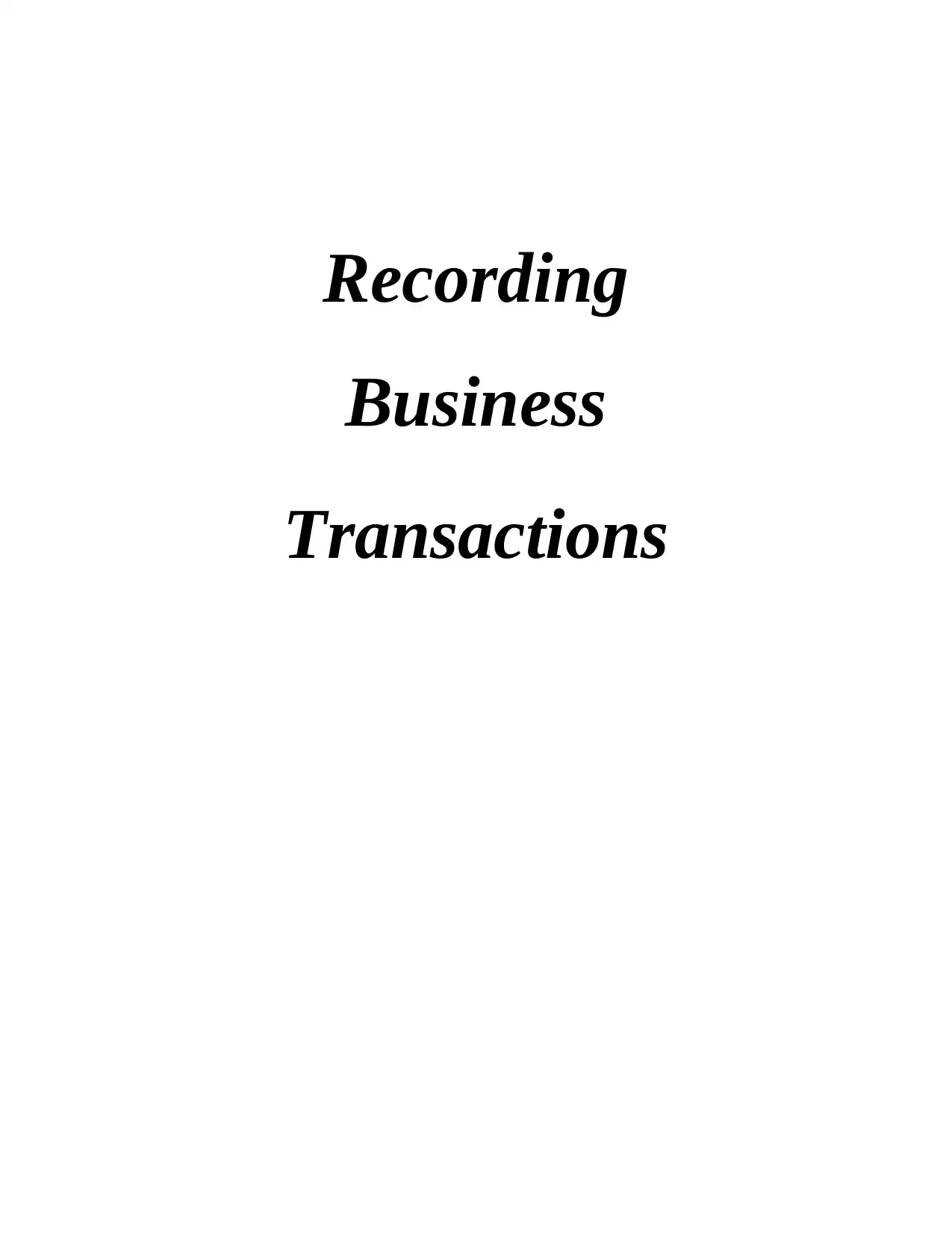
Recording
Business
Transactions
Business
Transactions
Secure Best Marks with AI Grader
Need help grading? Try our AI Grader for instant feedback on your assignments.
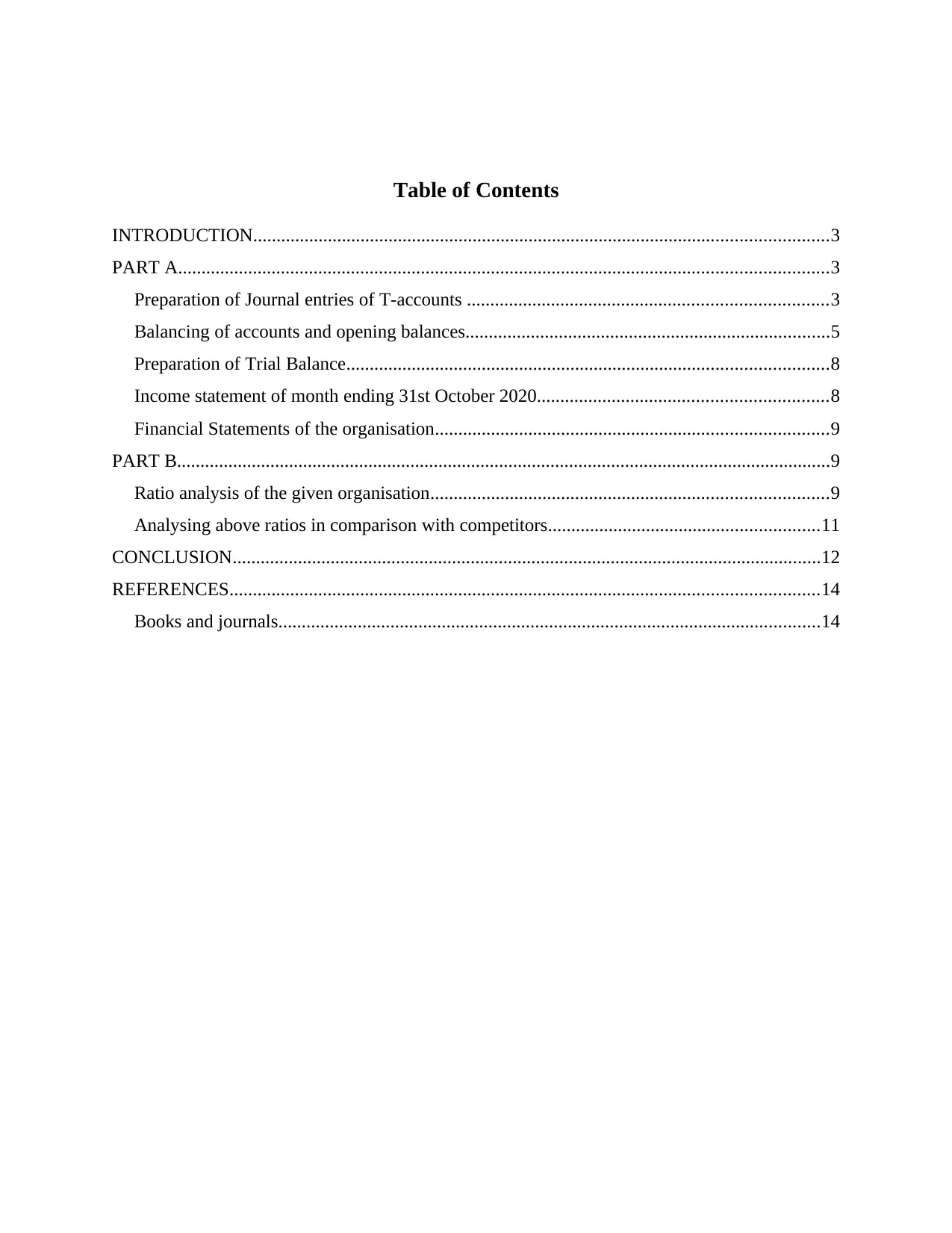
Table of Contents
INTRODUCTION...........................................................................................................................3
PART A...........................................................................................................................................3
Preparation of Journal entries of T-accounts .............................................................................3
Balancing of accounts and opening balances..............................................................................5
Preparation of Trial Balance.......................................................................................................8
Income statement of month ending 31st October 2020..............................................................8
Financial Statements of the organisation....................................................................................9
PART B............................................................................................................................................9
Ratio analysis of the given organisation.....................................................................................9
Analysing above ratios in comparison with competitors..........................................................11
CONCLUSION..............................................................................................................................12
REFERENCES..............................................................................................................................14
Books and journals....................................................................................................................14
INTRODUCTION...........................................................................................................................3
PART A...........................................................................................................................................3
Preparation of Journal entries of T-accounts .............................................................................3
Balancing of accounts and opening balances..............................................................................5
Preparation of Trial Balance.......................................................................................................8
Income statement of month ending 31st October 2020..............................................................8
Financial Statements of the organisation....................................................................................9
PART B............................................................................................................................................9
Ratio analysis of the given organisation.....................................................................................9
Analysing above ratios in comparison with competitors..........................................................11
CONCLUSION..............................................................................................................................12
REFERENCES..............................................................................................................................14
Books and journals....................................................................................................................14
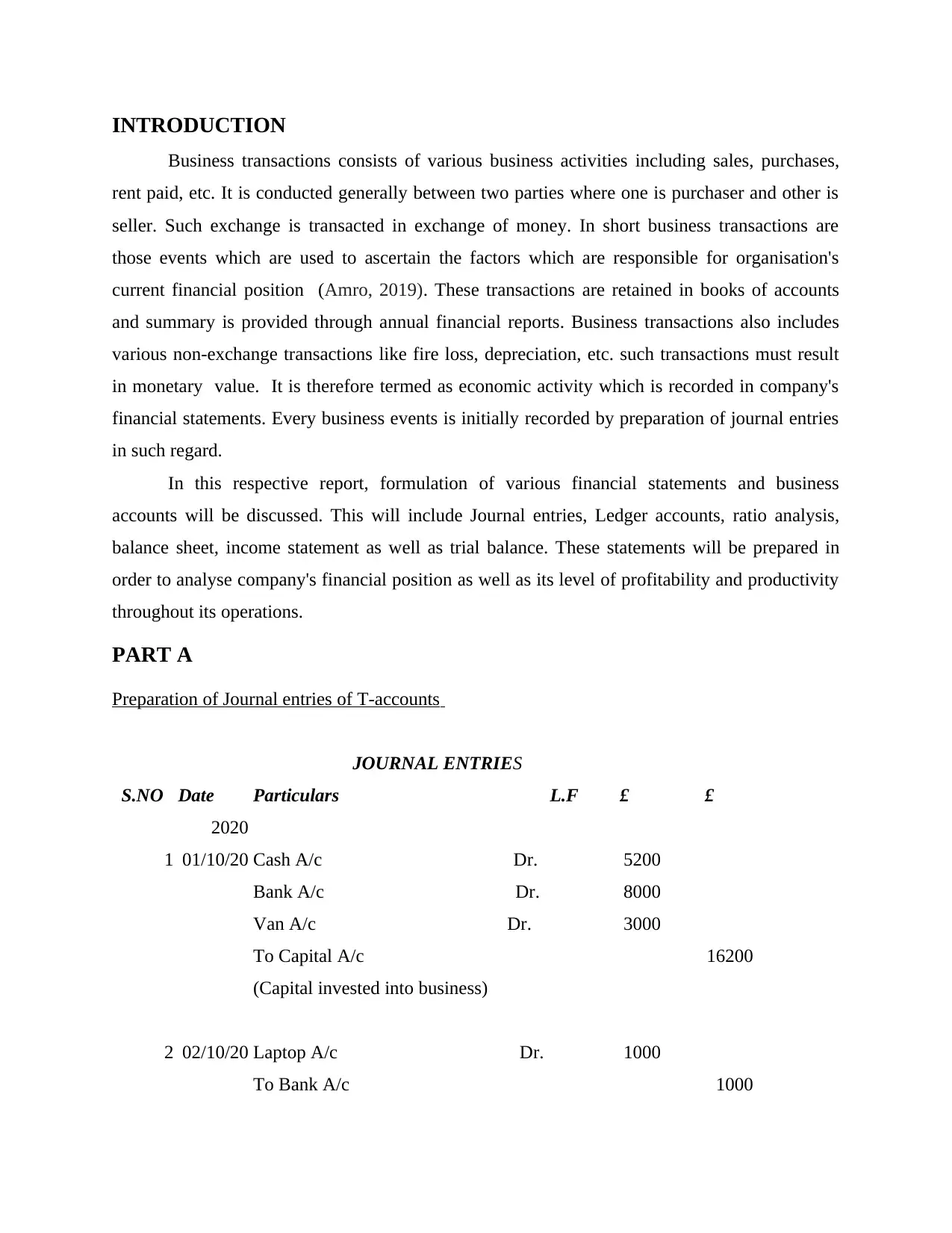
INTRODUCTION
Business transactions consists of various business activities including sales, purchases,
rent paid, etc. It is conducted generally between two parties where one is purchaser and other is
seller. Such exchange is transacted in exchange of money. In short business transactions are
those events which are used to ascertain the factors which are responsible for organisation's
current financial position (Amro, 2019). These transactions are retained in books of accounts
and summary is provided through annual financial reports. Business transactions also includes
various non-exchange transactions like fire loss, depreciation, etc. such transactions must result
in monetary value. It is therefore termed as economic activity which is recorded in company's
financial statements. Every business events is initially recorded by preparation of journal entries
in such regard.
In this respective report, formulation of various financial statements and business
accounts will be discussed. This will include Journal entries, Ledger accounts, ratio analysis,
balance sheet, income statement as well as trial balance. These statements will be prepared in
order to analyse company's financial position as well as its level of profitability and productivity
throughout its operations.
PART A
Preparation of Journal entries of T-accounts
JOURNAL ENTRIES
S.NO Date Particulars L.F £ £
2020
1 01/10/20 Cash A/c Dr. 5200
Bank A/c Dr. 8000
Van A/c Dr. 3000
To Capital A/c 16200
(Capital invested into business)
2 02/10/20 Laptop A/c Dr. 1000
To Bank A/c 1000
Business transactions consists of various business activities including sales, purchases,
rent paid, etc. It is conducted generally between two parties where one is purchaser and other is
seller. Such exchange is transacted in exchange of money. In short business transactions are
those events which are used to ascertain the factors which are responsible for organisation's
current financial position (Amro, 2019). These transactions are retained in books of accounts
and summary is provided through annual financial reports. Business transactions also includes
various non-exchange transactions like fire loss, depreciation, etc. such transactions must result
in monetary value. It is therefore termed as economic activity which is recorded in company's
financial statements. Every business events is initially recorded by preparation of journal entries
in such regard.
In this respective report, formulation of various financial statements and business
accounts will be discussed. This will include Journal entries, Ledger accounts, ratio analysis,
balance sheet, income statement as well as trial balance. These statements will be prepared in
order to analyse company's financial position as well as its level of profitability and productivity
throughout its operations.
PART A
Preparation of Journal entries of T-accounts
JOURNAL ENTRIES
S.NO Date Particulars L.F £ £
2020
1 01/10/20 Cash A/c Dr. 5200
Bank A/c Dr. 8000
Van A/c Dr. 3000
To Capital A/c 16200
(Capital invested into business)
2 02/10/20 Laptop A/c Dr. 1000
To Bank A/c 1000
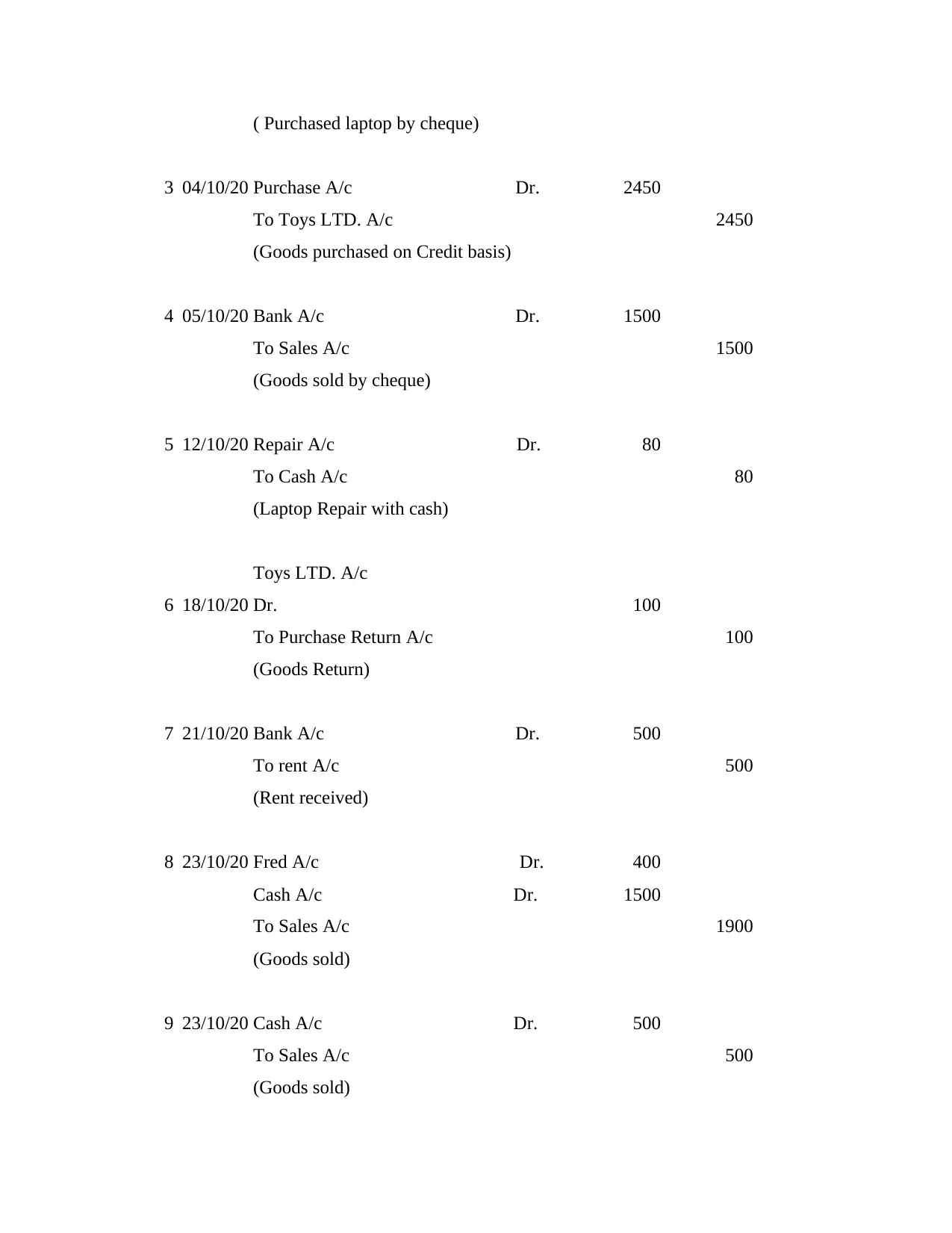
( Purchased laptop by cheque)
3 04/10/20 Purchase A/c Dr. 2450
To Toys LTD. A/c 2450
(Goods purchased on Credit basis)
4 05/10/20 Bank A/c Dr. 1500
To Sales A/c 1500
(Goods sold by cheque)
5 12/10/20 Repair A/c Dr. 80
To Cash A/c 80
(Laptop Repair with cash)
6 18/10/20
Toys LTD. A/c
Dr. 100
To Purchase Return A/c 100
(Goods Return)
7 21/10/20 Bank A/c Dr. 500
To rent A/c 500
(Rent received)
8 23/10/20 Fred A/c Dr. 400
Cash A/c Dr. 1500
To Sales A/c 1900
(Goods sold)
9 23/10/20 Cash A/c Dr. 500
To Sales A/c 500
(Goods sold)
3 04/10/20 Purchase A/c Dr. 2450
To Toys LTD. A/c 2450
(Goods purchased on Credit basis)
4 05/10/20 Bank A/c Dr. 1500
To Sales A/c 1500
(Goods sold by cheque)
5 12/10/20 Repair A/c Dr. 80
To Cash A/c 80
(Laptop Repair with cash)
6 18/10/20
Toys LTD. A/c
Dr. 100
To Purchase Return A/c 100
(Goods Return)
7 21/10/20 Bank A/c Dr. 500
To rent A/c 500
(Rent received)
8 23/10/20 Fred A/c Dr. 400
Cash A/c Dr. 1500
To Sales A/c 1900
(Goods sold)
9 23/10/20 Cash A/c Dr. 500
To Sales A/c 500
(Goods sold)
Secure Best Marks with AI Grader
Need help grading? Try our AI Grader for instant feedback on your assignments.
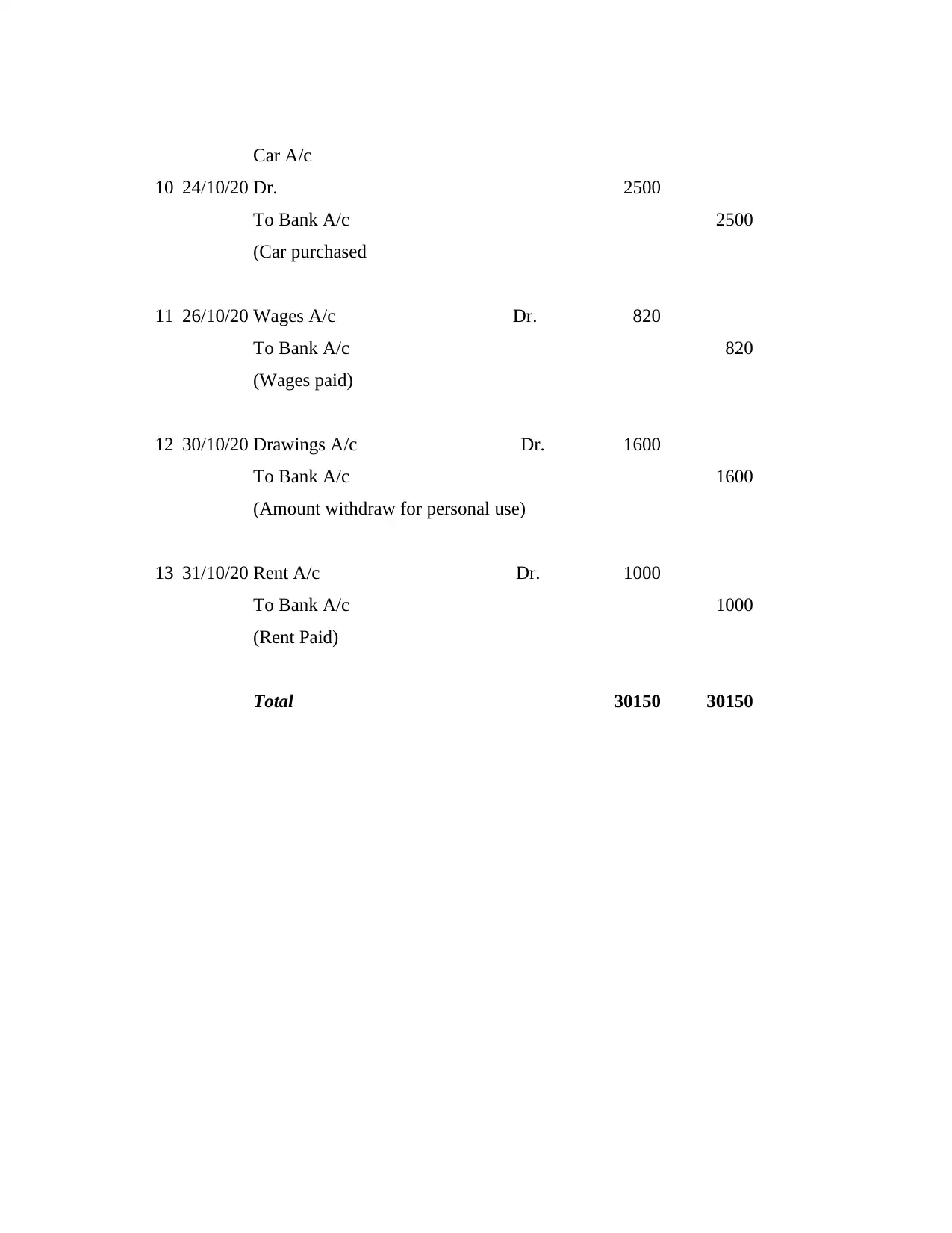
10 24/10/20
Car A/c
Dr. 2500
To Bank A/c 2500
(Car purchased
11 26/10/20 Wages A/c Dr. 820
To Bank A/c 820
(Wages paid)
12 30/10/20 Drawings A/c Dr. 1600
To Bank A/c 1600
(Amount withdraw for personal use)
13 31/10/20 Rent A/c Dr. 1000
To Bank A/c 1000
(Rent Paid)
Total 30150 30150
Car A/c
Dr. 2500
To Bank A/c 2500
(Car purchased
11 26/10/20 Wages A/c Dr. 820
To Bank A/c 820
(Wages paid)
12 30/10/20 Drawings A/c Dr. 1600
To Bank A/c 1600
(Amount withdraw for personal use)
13 31/10/20 Rent A/c Dr. 1000
To Bank A/c 1000
(Rent Paid)
Total 30150 30150
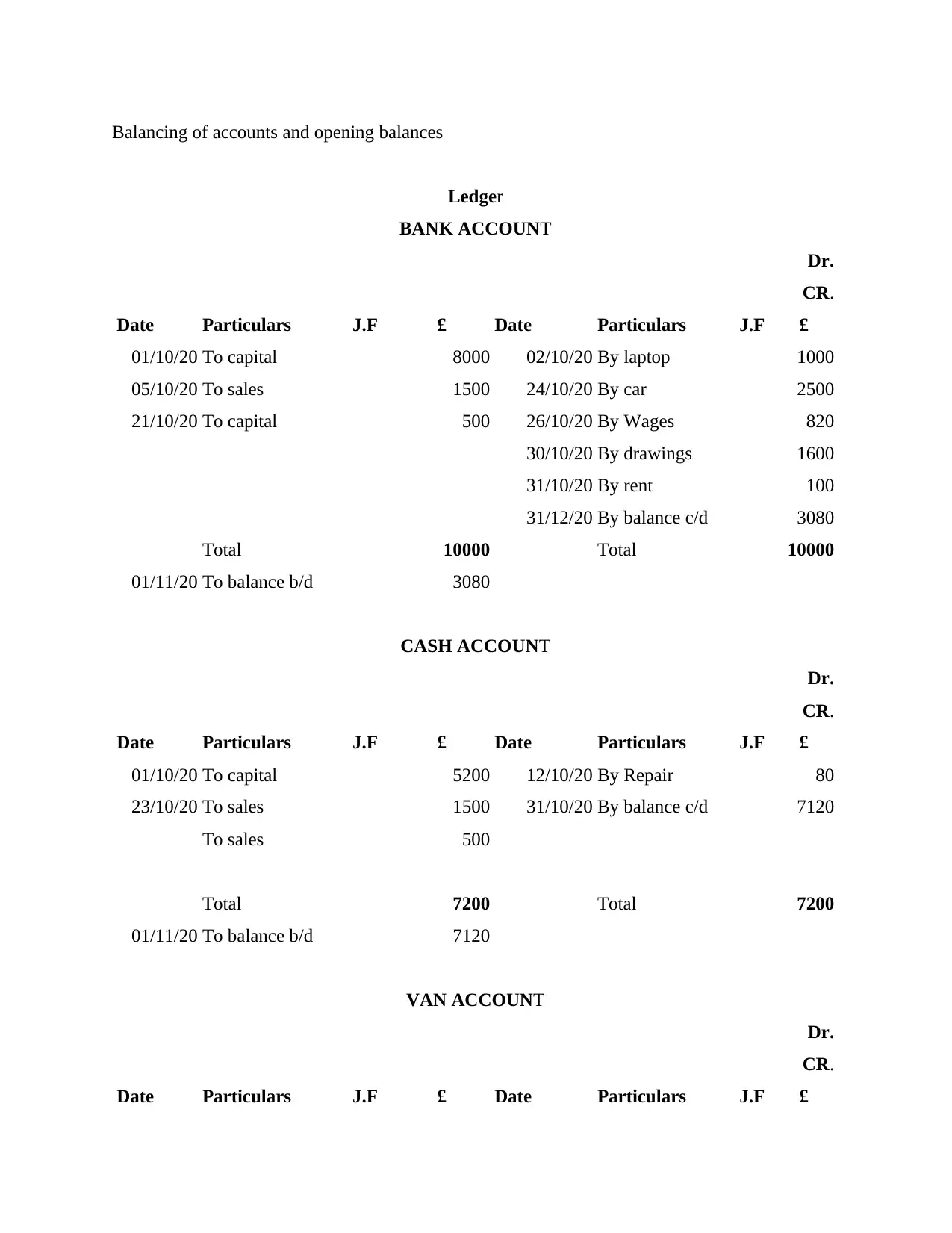
Balancing of accounts and opening balances
Ledger
BANK ACCOUNT
Dr.
CR.
Date Particulars J.F £ Date Particulars J.F £
01/10/20 To capital 8000 02/10/20 By laptop 1000
05/10/20 To sales 1500 24/10/20 By car 2500
21/10/20 To capital 500 26/10/20 By Wages 820
30/10/20 By drawings 1600
31/10/20 By rent 100
31/12/20 By balance c/d 3080
Total 10000 Total 10000
01/11/20 To balance b/d 3080
CASH ACCOUNT
Dr.
CR.
Date Particulars J.F £ Date Particulars J.F £
01/10/20 To capital 5200 12/10/20 By Repair 80
23/10/20 To sales 1500 31/10/20 By balance c/d 7120
To sales 500
Total 7200 Total 7200
01/11/20 To balance b/d 7120
VAN ACCOUNT
Dr.
CR.
Date Particulars J.F £ Date Particulars J.F £
Ledger
BANK ACCOUNT
Dr.
CR.
Date Particulars J.F £ Date Particulars J.F £
01/10/20 To capital 8000 02/10/20 By laptop 1000
05/10/20 To sales 1500 24/10/20 By car 2500
21/10/20 To capital 500 26/10/20 By Wages 820
30/10/20 By drawings 1600
31/10/20 By rent 100
31/12/20 By balance c/d 3080
Total 10000 Total 10000
01/11/20 To balance b/d 3080
CASH ACCOUNT
Dr.
CR.
Date Particulars J.F £ Date Particulars J.F £
01/10/20 To capital 5200 12/10/20 By Repair 80
23/10/20 To sales 1500 31/10/20 By balance c/d 7120
To sales 500
Total 7200 Total 7200
01/11/20 To balance b/d 7120
VAN ACCOUNT
Dr.
CR.
Date Particulars J.F £ Date Particulars J.F £
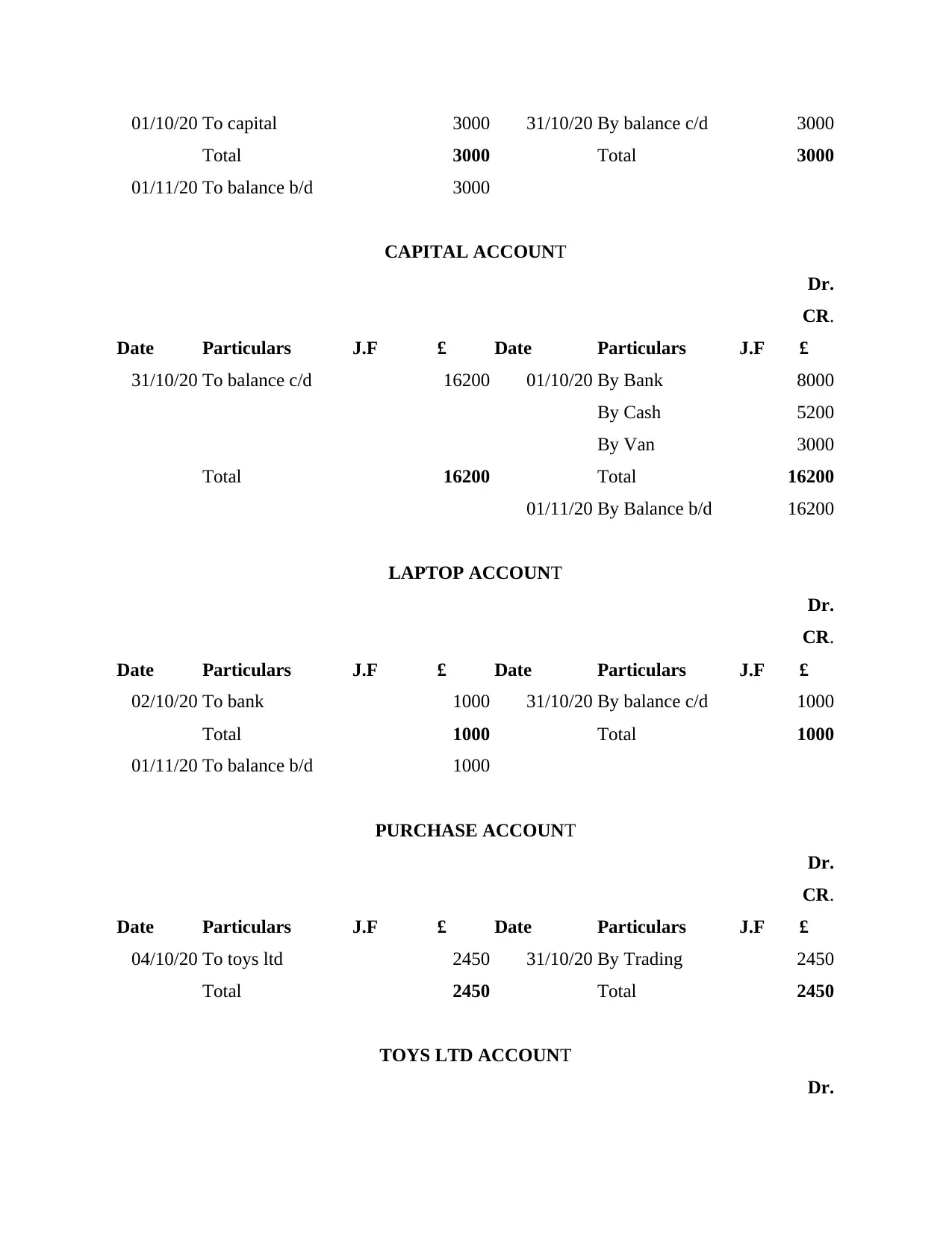
01/10/20 To capital 3000 31/10/20 By balance c/d 3000
Total 3000 Total 3000
01/11/20 To balance b/d 3000
CAPITAL ACCOUNT
Dr.
CR.
Date Particulars J.F £ Date Particulars J.F £
31/10/20 To balance c/d 16200 01/10/20 By Bank 8000
By Cash 5200
By Van 3000
Total 16200 Total 16200
01/11/20 By Balance b/d 16200
LAPTOP ACCOUNT
Dr.
CR.
Date Particulars J.F £ Date Particulars J.F £
02/10/20 To bank 1000 31/10/20 By balance c/d 1000
Total 1000 Total 1000
01/11/20 To balance b/d 1000
PURCHASE ACCOUNT
Dr.
CR.
Date Particulars J.F £ Date Particulars J.F £
04/10/20 To toys ltd 2450 31/10/20 By Trading 2450
Total 2450 Total 2450
TOYS LTD ACCOUNT
Dr.
Total 3000 Total 3000
01/11/20 To balance b/d 3000
CAPITAL ACCOUNT
Dr.
CR.
Date Particulars J.F £ Date Particulars J.F £
31/10/20 To balance c/d 16200 01/10/20 By Bank 8000
By Cash 5200
By Van 3000
Total 16200 Total 16200
01/11/20 By Balance b/d 16200
LAPTOP ACCOUNT
Dr.
CR.
Date Particulars J.F £ Date Particulars J.F £
02/10/20 To bank 1000 31/10/20 By balance c/d 1000
Total 1000 Total 1000
01/11/20 To balance b/d 1000
PURCHASE ACCOUNT
Dr.
CR.
Date Particulars J.F £ Date Particulars J.F £
04/10/20 To toys ltd 2450 31/10/20 By Trading 2450
Total 2450 Total 2450
TOYS LTD ACCOUNT
Dr.
Paraphrase This Document
Need a fresh take? Get an instant paraphrase of this document with our AI Paraphraser
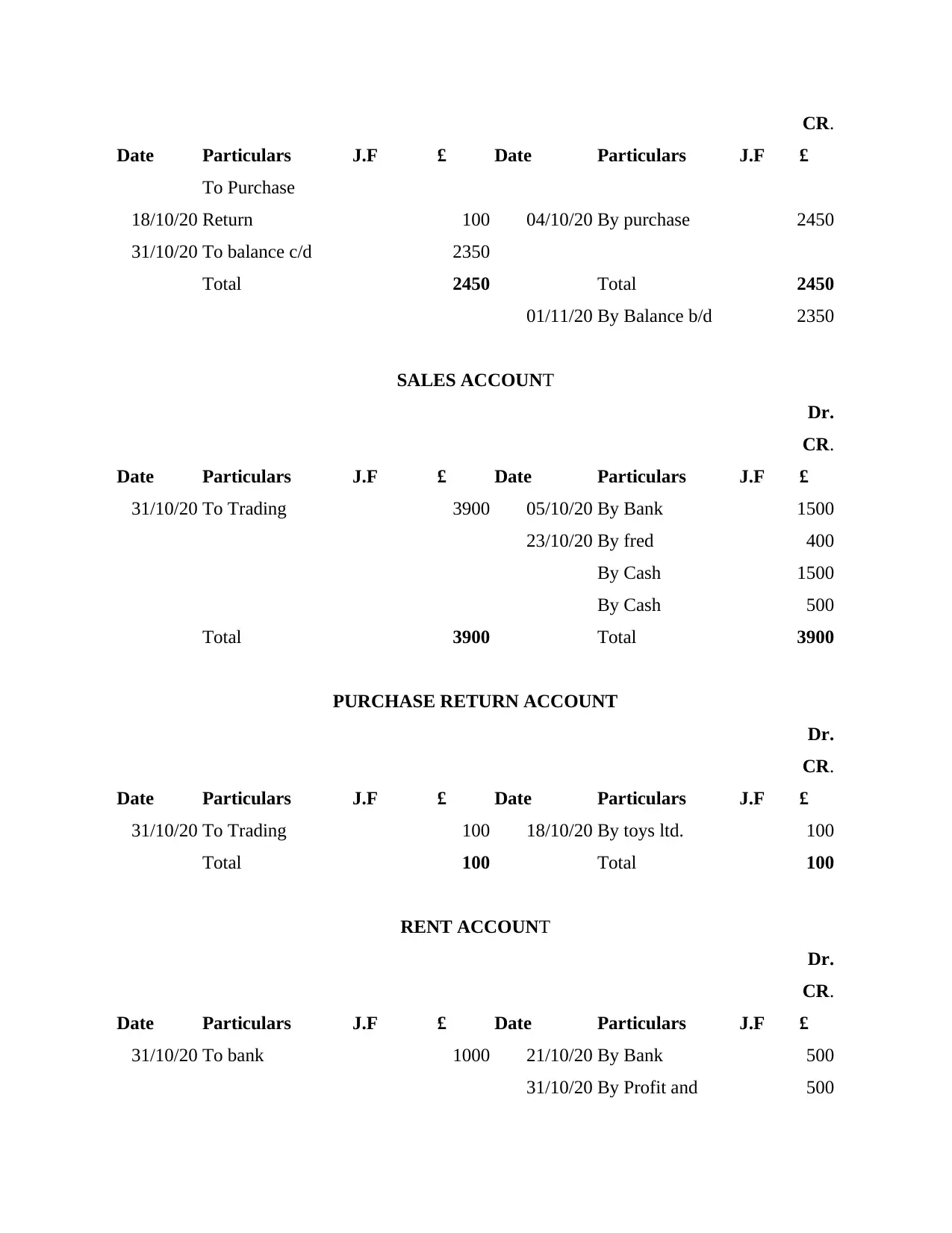
CR.
Date Particulars J.F £ Date Particulars J.F £
18/10/20
To Purchase
Return 100 04/10/20 By purchase 2450
31/10/20 To balance c/d 2350
Total 2450 Total 2450
01/11/20 By Balance b/d 2350
SALES ACCOUNT
Dr.
CR.
Date Particulars J.F £ Date Particulars J.F £
31/10/20 To Trading 3900 05/10/20 By Bank 1500
23/10/20 By fred 400
By Cash 1500
By Cash 500
Total 3900 Total 3900
PURCHASE RETURN ACCOUNT
Dr.
CR.
Date Particulars J.F £ Date Particulars J.F £
31/10/20 To Trading 100 18/10/20 By toys ltd. 100
Total 100 Total 100
RENT ACCOUNT
Dr.
CR.
Date Particulars J.F £ Date Particulars J.F £
31/10/20 To bank 1000 21/10/20 By Bank 500
31/10/20 By Profit and 500
Date Particulars J.F £ Date Particulars J.F £
18/10/20
To Purchase
Return 100 04/10/20 By purchase 2450
31/10/20 To balance c/d 2350
Total 2450 Total 2450
01/11/20 By Balance b/d 2350
SALES ACCOUNT
Dr.
CR.
Date Particulars J.F £ Date Particulars J.F £
31/10/20 To Trading 3900 05/10/20 By Bank 1500
23/10/20 By fred 400
By Cash 1500
By Cash 500
Total 3900 Total 3900
PURCHASE RETURN ACCOUNT
Dr.
CR.
Date Particulars J.F £ Date Particulars J.F £
31/10/20 To Trading 100 18/10/20 By toys ltd. 100
Total 100 Total 100
RENT ACCOUNT
Dr.
CR.
Date Particulars J.F £ Date Particulars J.F £
31/10/20 To bank 1000 21/10/20 By Bank 500
31/10/20 By Profit and 500
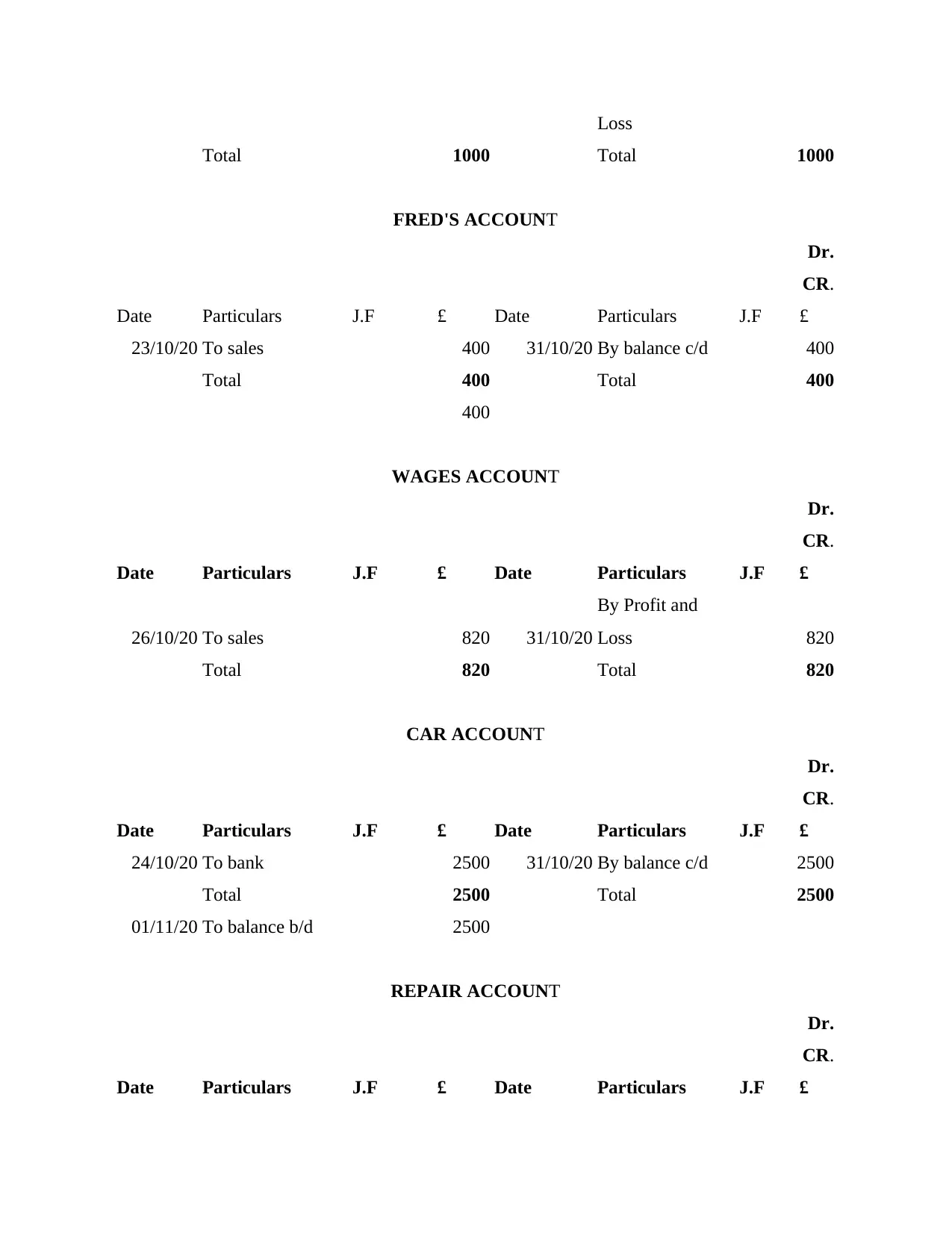
Loss
Total 1000 Total 1000
FRED'S ACCOUNT
Dr.
CR.
Date Particulars J.F £ Date Particulars J.F £
23/10/20 To sales 400 31/10/20 By balance c/d 400
Total 400 Total 400
400
WAGES ACCOUNT
Dr.
CR.
Date Particulars J.F £ Date Particulars J.F £
26/10/20 To sales 820 31/10/20
By Profit and
Loss 820
Total 820 Total 820
CAR ACCOUNT
Dr.
CR.
Date Particulars J.F £ Date Particulars J.F £
24/10/20 To bank 2500 31/10/20 By balance c/d 2500
Total 2500 Total 2500
01/11/20 To balance b/d 2500
REPAIR ACCOUNT
Dr.
CR.
Date Particulars J.F £ Date Particulars J.F £
Total 1000 Total 1000
FRED'S ACCOUNT
Dr.
CR.
Date Particulars J.F £ Date Particulars J.F £
23/10/20 To sales 400 31/10/20 By balance c/d 400
Total 400 Total 400
400
WAGES ACCOUNT
Dr.
CR.
Date Particulars J.F £ Date Particulars J.F £
26/10/20 To sales 820 31/10/20
By Profit and
Loss 820
Total 820 Total 820
CAR ACCOUNT
Dr.
CR.
Date Particulars J.F £ Date Particulars J.F £
24/10/20 To bank 2500 31/10/20 By balance c/d 2500
Total 2500 Total 2500
01/11/20 To balance b/d 2500
REPAIR ACCOUNT
Dr.
CR.
Date Particulars J.F £ Date Particulars J.F £
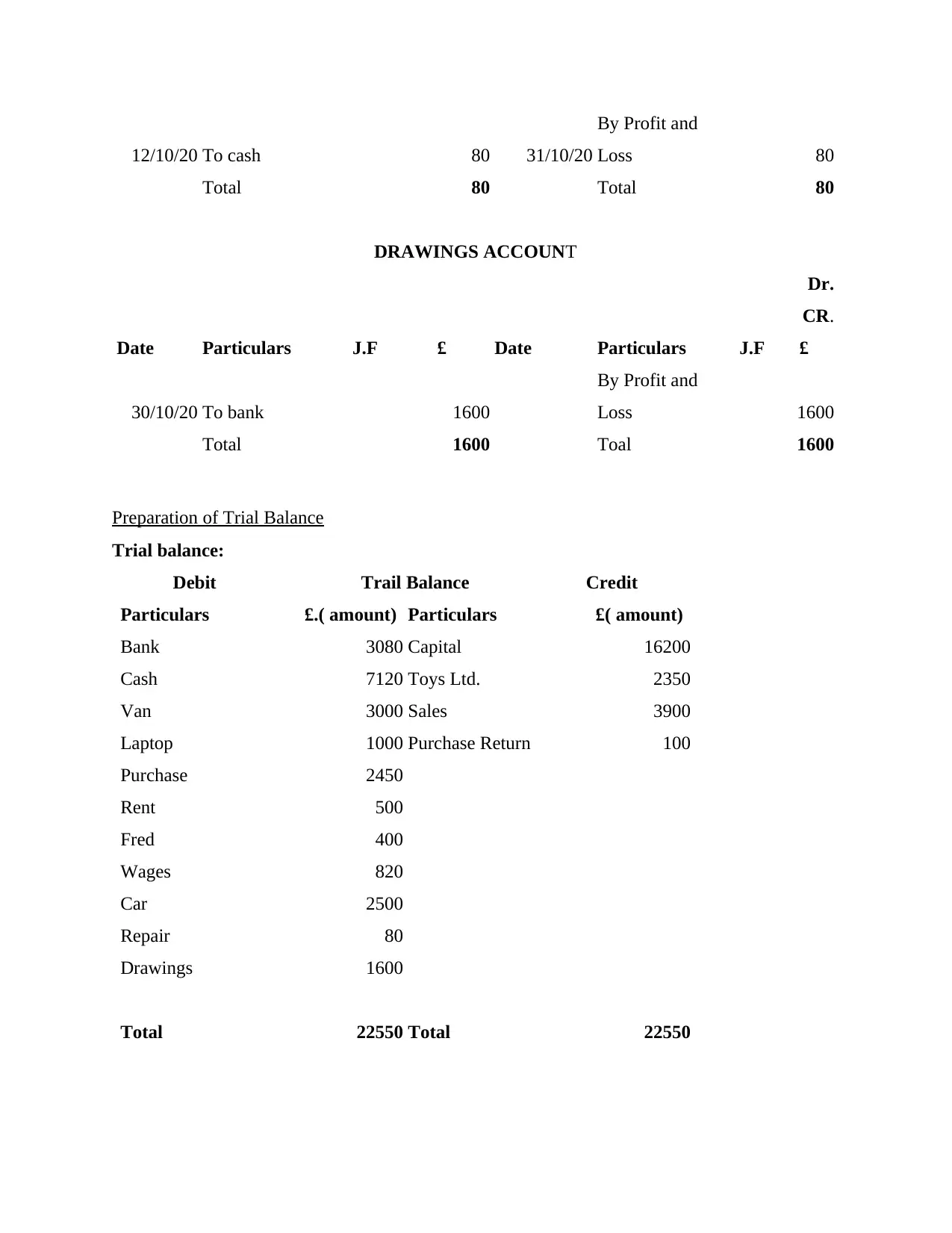
12/10/20 To cash 80 31/10/20
By Profit and
Loss 80
Total 80 Total 80
DRAWINGS ACCOUNT
Dr.
CR.
Date Particulars J.F £ Date Particulars J.F £
30/10/20 To bank 1600
By Profit and
Loss 1600
Total 1600 Toal 1600
Preparation of Trial Balance
Trial balance:
Debit Trail Balance Credit
Particulars £.( amount) Particulars £( amount)
Bank 3080 Capital 16200
Cash 7120 Toys Ltd. 2350
Van 3000 Sales 3900
Laptop 1000 Purchase Return 100
Purchase 2450
Rent 500
Fred 400
Wages 820
Car 2500
Repair 80
Drawings 1600
Total 22550 Total 22550
By Profit and
Loss 80
Total 80 Total 80
DRAWINGS ACCOUNT
Dr.
CR.
Date Particulars J.F £ Date Particulars J.F £
30/10/20 To bank 1600
By Profit and
Loss 1600
Total 1600 Toal 1600
Preparation of Trial Balance
Trial balance:
Debit Trail Balance Credit
Particulars £.( amount) Particulars £( amount)
Bank 3080 Capital 16200
Cash 7120 Toys Ltd. 2350
Van 3000 Sales 3900
Laptop 1000 Purchase Return 100
Purchase 2450
Rent 500
Fred 400
Wages 820
Car 2500
Repair 80
Drawings 1600
Total 22550 Total 22550
Secure Best Marks with AI Grader
Need help grading? Try our AI Grader for instant feedback on your assignments.
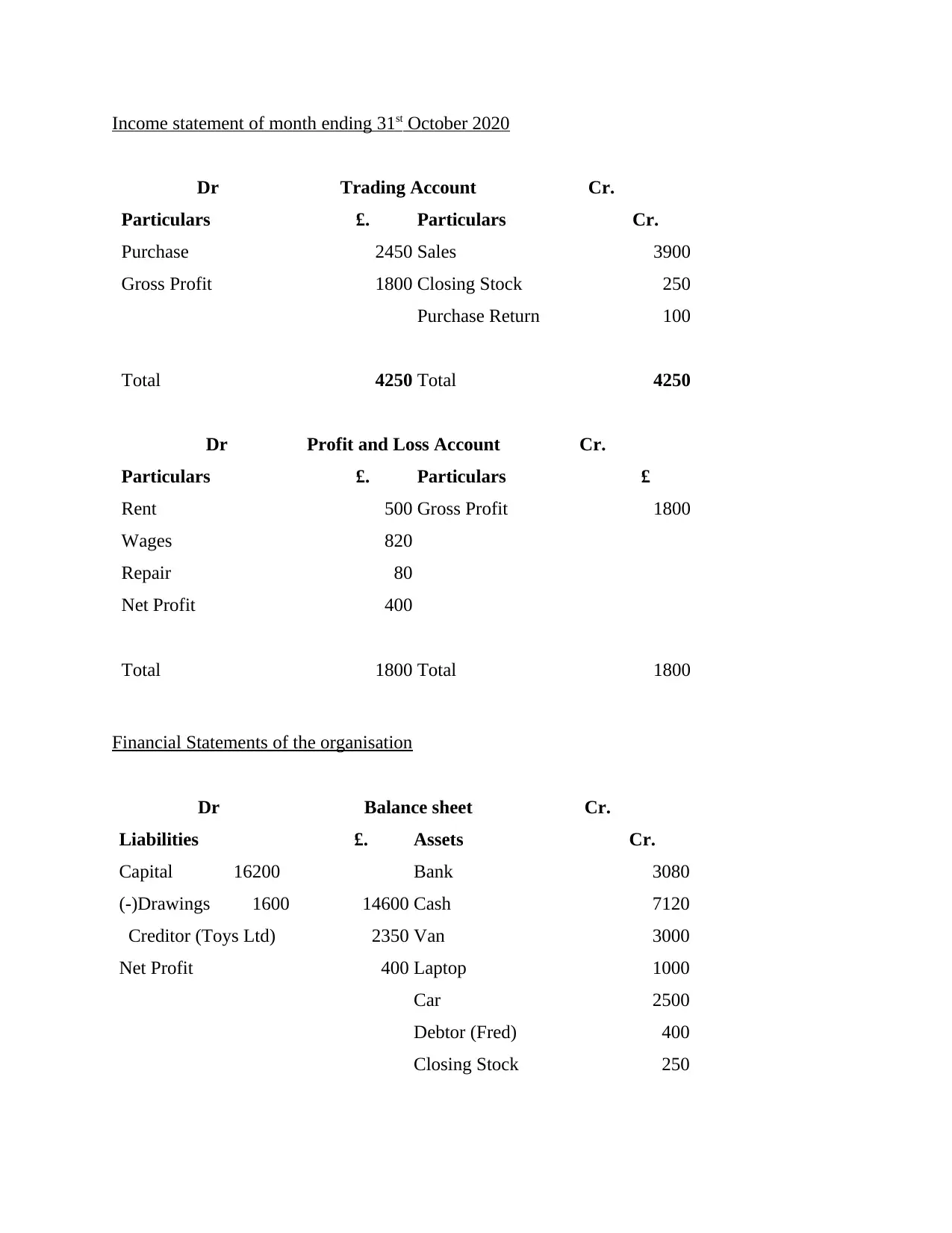
Income statement of month ending 31st October 2020
Dr Trading Account Cr.
Particulars £. Particulars Cr.
Purchase 2450 Sales 3900
Gross Profit 1800 Closing Stock 250
Purchase Return 100
Total 4250 Total 4250
Dr Profit and Loss Account Cr.
Particulars £. Particulars £
Rent 500 Gross Profit 1800
Wages 820
Repair 80
Net Profit 400
Total 1800 Total 1800
Financial Statements of the organisation
Dr Balance sheet Cr.
Liabilities £. Assets Cr.
Capital 16200 Bank 3080
(-)Drawings 1600 14600 Cash 7120
Creditor (Toys Ltd) 2350 Van 3000
Net Profit 400 Laptop 1000
Car 2500
Debtor (Fred) 400
Closing Stock 250
Dr Trading Account Cr.
Particulars £. Particulars Cr.
Purchase 2450 Sales 3900
Gross Profit 1800 Closing Stock 250
Purchase Return 100
Total 4250 Total 4250
Dr Profit and Loss Account Cr.
Particulars £. Particulars £
Rent 500 Gross Profit 1800
Wages 820
Repair 80
Net Profit 400
Total 1800 Total 1800
Financial Statements of the organisation
Dr Balance sheet Cr.
Liabilities £. Assets Cr.
Capital 16200 Bank 3080
(-)Drawings 1600 14600 Cash 7120
Creditor (Toys Ltd) 2350 Van 3000
Net Profit 400 Laptop 1000
Car 2500
Debtor (Fred) 400
Closing Stock 250
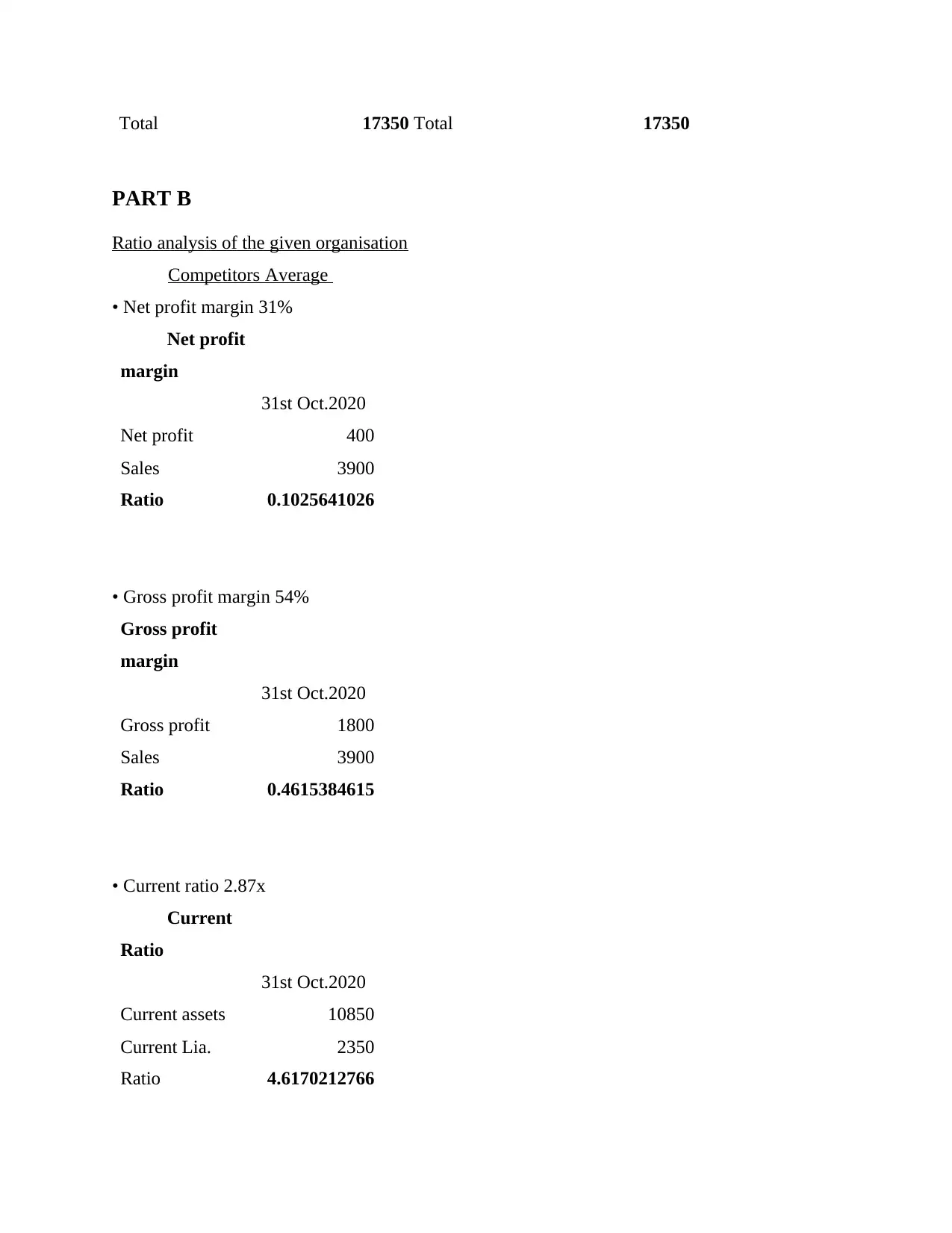
Total 17350 Total 17350
PART B
Ratio analysis of the given organisation
Competitors Average
• Net profit margin 31%
Net profit
margin
31st Oct.2020
Net profit 400
Sales 3900
Ratio 0.1025641026
• Gross profit margin 54%
Gross profit
margin
31st Oct.2020
Gross profit 1800
Sales 3900
Ratio 0.4615384615
• Current ratio 2.87x
Current
Ratio
31st Oct.2020
Current assets 10850
Current Lia. 2350
Ratio 4.6170212766
PART B
Ratio analysis of the given organisation
Competitors Average
• Net profit margin 31%
Net profit
margin
31st Oct.2020
Net profit 400
Sales 3900
Ratio 0.1025641026
• Gross profit margin 54%
Gross profit
margin
31st Oct.2020
Gross profit 1800
Sales 3900
Ratio 0.4615384615
• Current ratio 2.87x
Current
Ratio
31st Oct.2020
Current assets 10850
Current Lia. 2350
Ratio 4.6170212766
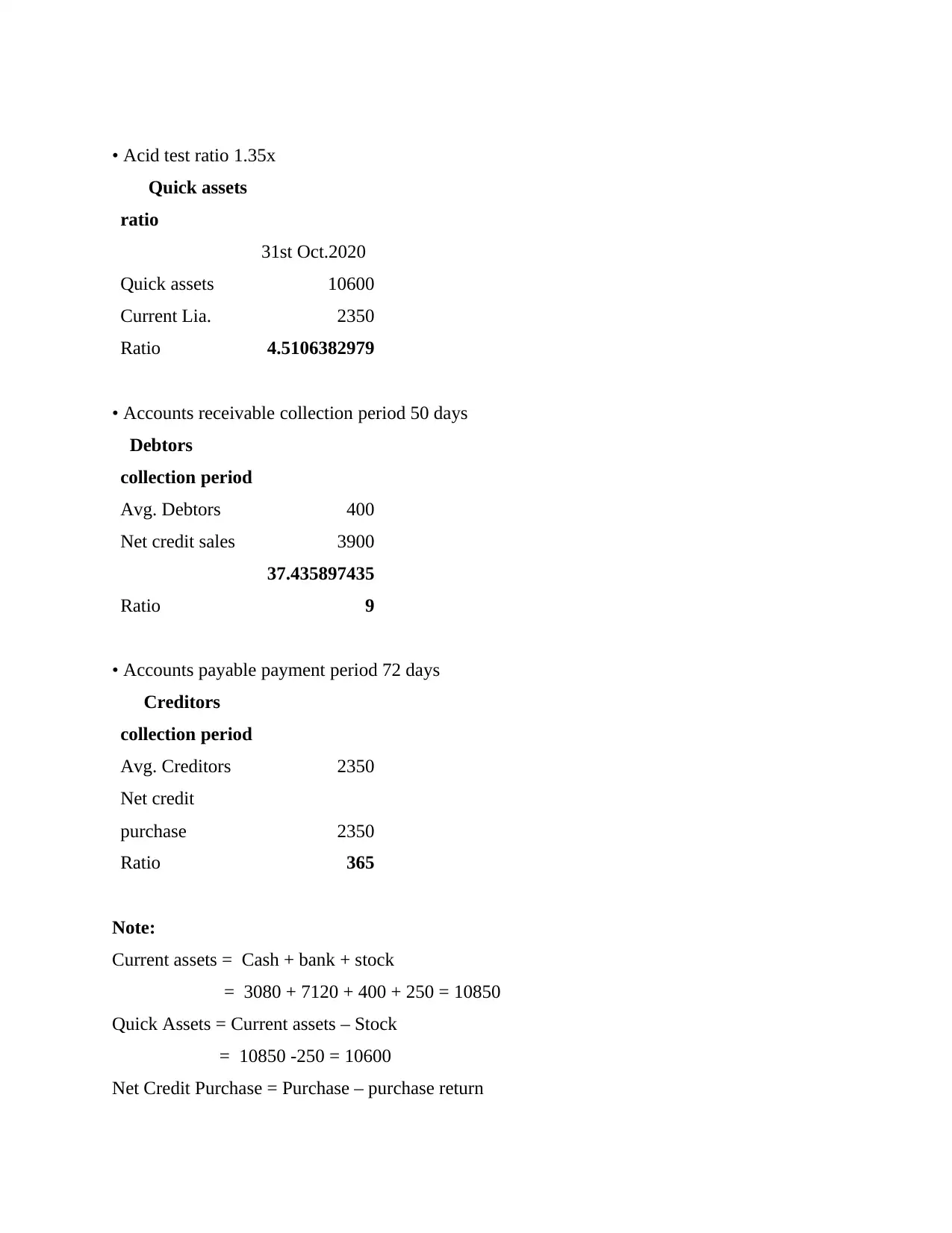
• Acid test ratio 1.35x
Quick assets
ratio
31st Oct.2020
Quick assets 10600
Current Lia. 2350
Ratio 4.5106382979
• Accounts receivable collection period 50 days
Debtors
collection period
Avg. Debtors 400
Net credit sales 3900
Ratio
37.435897435
9
• Accounts payable payment period 72 days
Creditors
collection period
Avg. Creditors 2350
Net credit
purchase 2350
Ratio 365
Note:
Current assets = Cash + bank + stock
= 3080 + 7120 + 400 + 250 = 10850
Quick Assets = Current assets – Stock
= 10850 -250 = 10600
Net Credit Purchase = Purchase – purchase return
Quick assets
ratio
31st Oct.2020
Quick assets 10600
Current Lia. 2350
Ratio 4.5106382979
• Accounts receivable collection period 50 days
Debtors
collection period
Avg. Debtors 400
Net credit sales 3900
Ratio
37.435897435
9
• Accounts payable payment period 72 days
Creditors
collection period
Avg. Creditors 2350
Net credit
purchase 2350
Ratio 365
Note:
Current assets = Cash + bank + stock
= 3080 + 7120 + 400 + 250 = 10850
Quick Assets = Current assets – Stock
= 10850 -250 = 10600
Net Credit Purchase = Purchase – purchase return
Paraphrase This Document
Need a fresh take? Get an instant paraphrase of this document with our AI Paraphraser
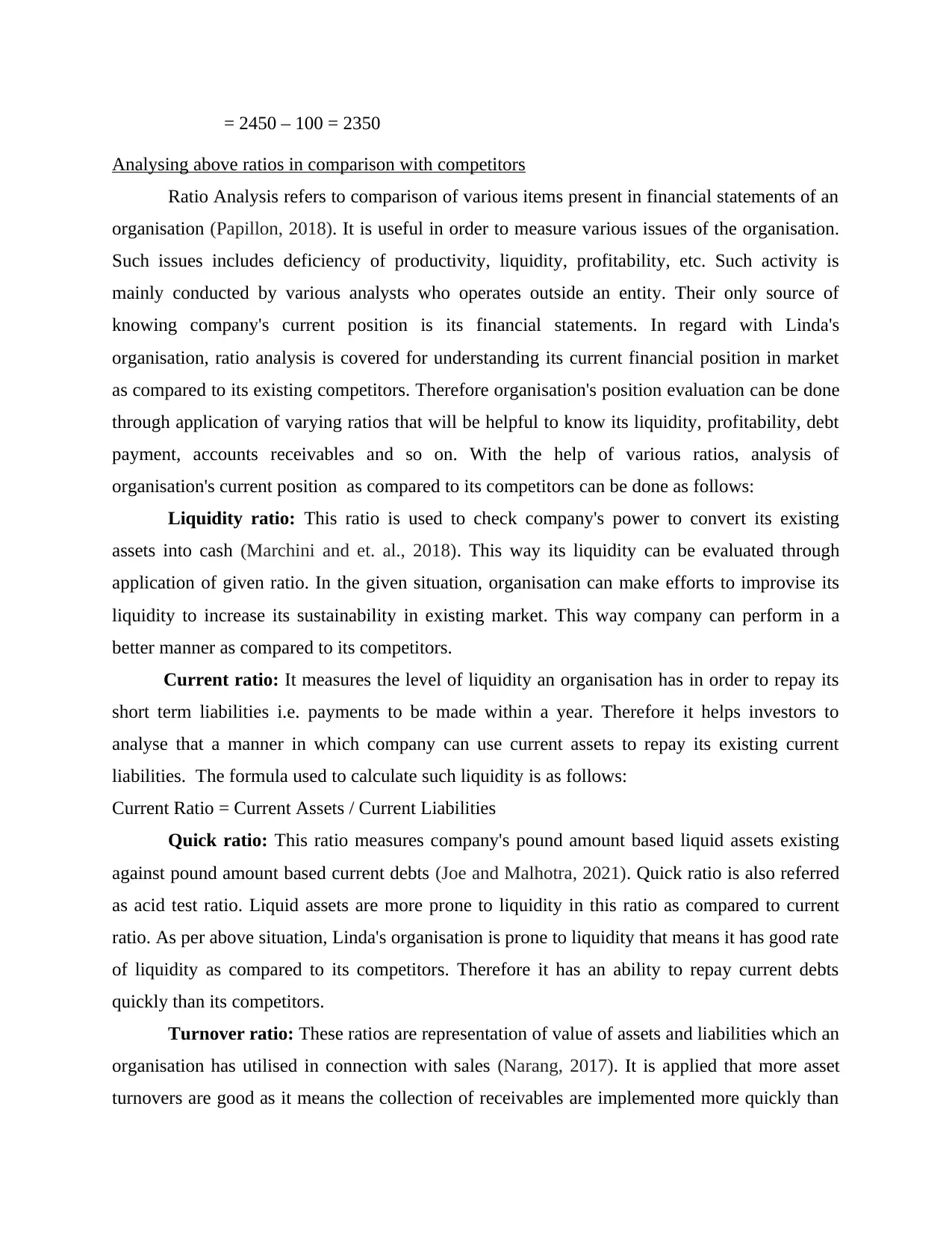
= 2450 – 100 = 2350
Analysing above ratios in comparison with competitors
Ratio Analysis refers to comparison of various items present in financial statements of an
organisation (Papillon, 2018). It is useful in order to measure various issues of the organisation.
Such issues includes deficiency of productivity, liquidity, profitability, etc. Such activity is
mainly conducted by various analysts who operates outside an entity. Their only source of
knowing company's current position is its financial statements. In regard with Linda's
organisation, ratio analysis is covered for understanding its current financial position in market
as compared to its existing competitors. Therefore organisation's position evaluation can be done
through application of varying ratios that will be helpful to know its liquidity, profitability, debt
payment, accounts receivables and so on. With the help of various ratios, analysis of
organisation's current position as compared to its competitors can be done as follows:
Liquidity ratio: This ratio is used to check company's power to convert its existing
assets into cash (Marchini and et. al., 2018). This way its liquidity can be evaluated through
application of given ratio. In the given situation, organisation can make efforts to improvise its
liquidity to increase its sustainability in existing market. This way company can perform in a
better manner as compared to its competitors.
Current ratio: It measures the level of liquidity an organisation has in order to repay its
short term liabilities i.e. payments to be made within a year. Therefore it helps investors to
analyse that a manner in which company can use current assets to repay its existing current
liabilities. The formula used to calculate such liquidity is as follows:
Current Ratio = Current Assets / Current Liabilities
Quick ratio: This ratio measures company's pound amount based liquid assets existing
against pound amount based current debts (Joe and Malhotra, 2021). Quick ratio is also referred
as acid test ratio. Liquid assets are more prone to liquidity in this ratio as compared to current
ratio. As per above situation, Linda's organisation is prone to liquidity that means it has good rate
of liquidity as compared to its competitors. Therefore it has an ability to repay current debts
quickly than its competitors.
Turnover ratio: These ratios are representation of value of assets and liabilities which an
organisation has utilised in connection with sales (Narang, 2017). It is applied that more asset
turnovers are good as it means the collection of receivables are implemented more quickly than
Analysing above ratios in comparison with competitors
Ratio Analysis refers to comparison of various items present in financial statements of an
organisation (Papillon, 2018). It is useful in order to measure various issues of the organisation.
Such issues includes deficiency of productivity, liquidity, profitability, etc. Such activity is
mainly conducted by various analysts who operates outside an entity. Their only source of
knowing company's current position is its financial statements. In regard with Linda's
organisation, ratio analysis is covered for understanding its current financial position in market
as compared to its existing competitors. Therefore organisation's position evaluation can be done
through application of varying ratios that will be helpful to know its liquidity, profitability, debt
payment, accounts receivables and so on. With the help of various ratios, analysis of
organisation's current position as compared to its competitors can be done as follows:
Liquidity ratio: This ratio is used to check company's power to convert its existing
assets into cash (Marchini and et. al., 2018). This way its liquidity can be evaluated through
application of given ratio. In the given situation, organisation can make efforts to improvise its
liquidity to increase its sustainability in existing market. This way company can perform in a
better manner as compared to its competitors.
Current ratio: It measures the level of liquidity an organisation has in order to repay its
short term liabilities i.e. payments to be made within a year. Therefore it helps investors to
analyse that a manner in which company can use current assets to repay its existing current
liabilities. The formula used to calculate such liquidity is as follows:
Current Ratio = Current Assets / Current Liabilities
Quick ratio: This ratio measures company's pound amount based liquid assets existing
against pound amount based current debts (Joe and Malhotra, 2021). Quick ratio is also referred
as acid test ratio. Liquid assets are more prone to liquidity in this ratio as compared to current
ratio. As per above situation, Linda's organisation is prone to liquidity that means it has good rate
of liquidity as compared to its competitors. Therefore it has an ability to repay current debts
quickly than its competitors.
Turnover ratio: These ratios are representation of value of assets and liabilities which an
organisation has utilised in connection with sales (Narang, 2017). It is applied that more asset
turnovers are good as it means the collection of receivables are implemented more quickly than
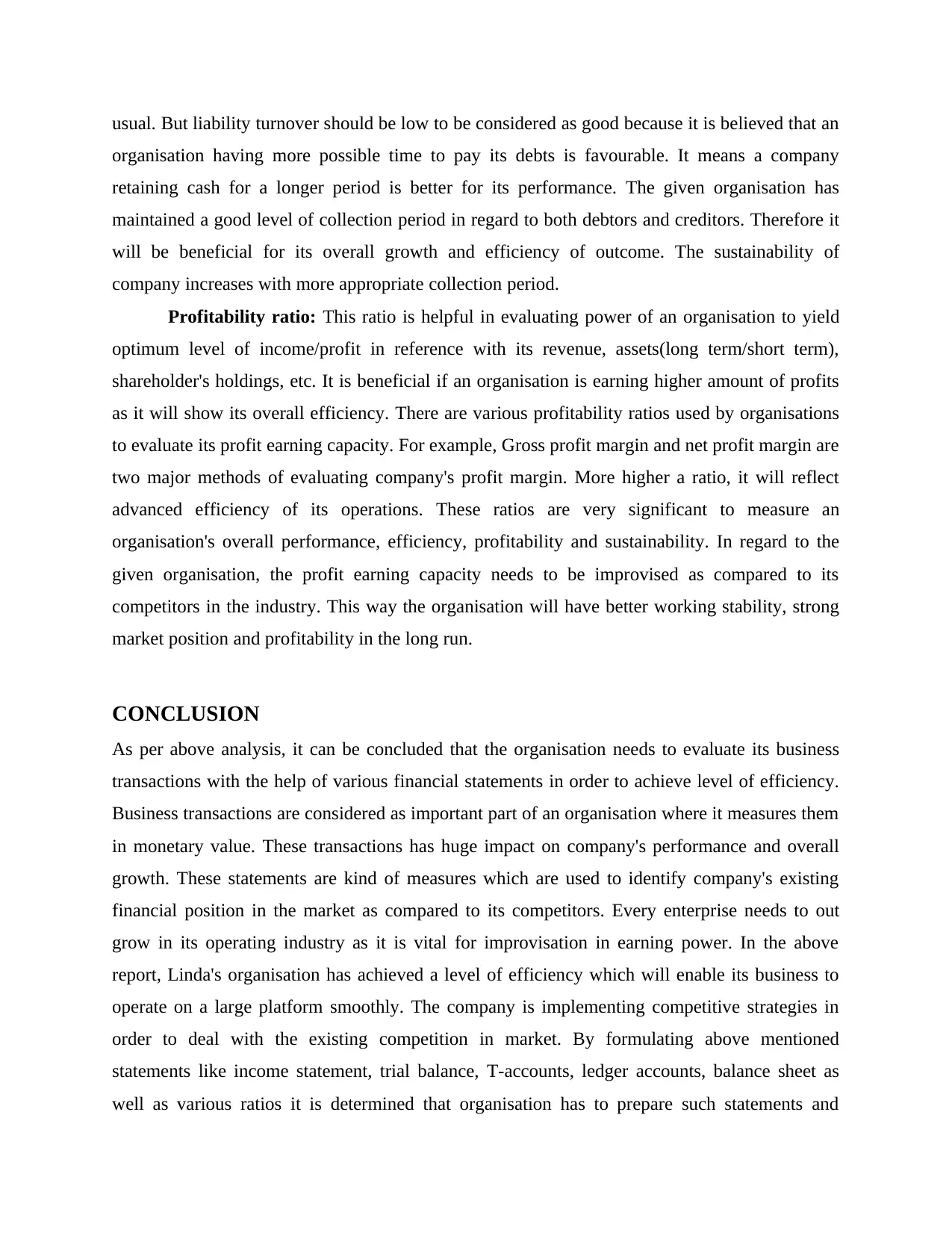
usual. But liability turnover should be low to be considered as good because it is believed that an
organisation having more possible time to pay its debts is favourable. It means a company
retaining cash for a longer period is better for its performance. The given organisation has
maintained a good level of collection period in regard to both debtors and creditors. Therefore it
will be beneficial for its overall growth and efficiency of outcome. The sustainability of
company increases with more appropriate collection period.
Profitability ratio: This ratio is helpful in evaluating power of an organisation to yield
optimum level of income/profit in reference with its revenue, assets(long term/short term),
shareholder's holdings, etc. It is beneficial if an organisation is earning higher amount of profits
as it will show its overall efficiency. There are various profitability ratios used by organisations
to evaluate its profit earning capacity. For example, Gross profit margin and net profit margin are
two major methods of evaluating company's profit margin. More higher a ratio, it will reflect
advanced efficiency of its operations. These ratios are very significant to measure an
organisation's overall performance, efficiency, profitability and sustainability. In regard to the
given organisation, the profit earning capacity needs to be improvised as compared to its
competitors in the industry. This way the organisation will have better working stability, strong
market position and profitability in the long run.
CONCLUSION
As per above analysis, it can be concluded that the organisation needs to evaluate its business
transactions with the help of various financial statements in order to achieve level of efficiency.
Business transactions are considered as important part of an organisation where it measures them
in monetary value. These transactions has huge impact on company's performance and overall
growth. These statements are kind of measures which are used to identify company's existing
financial position in the market as compared to its competitors. Every enterprise needs to out
grow in its operating industry as it is vital for improvisation in earning power. In the above
report, Linda's organisation has achieved a level of efficiency which will enable its business to
operate on a large platform smoothly. The company is implementing competitive strategies in
order to deal with the existing competition in market. By formulating above mentioned
statements like income statement, trial balance, T-accounts, ledger accounts, balance sheet as
well as various ratios it is determined that organisation has to prepare such statements and
organisation having more possible time to pay its debts is favourable. It means a company
retaining cash for a longer period is better for its performance. The given organisation has
maintained a good level of collection period in regard to both debtors and creditors. Therefore it
will be beneficial for its overall growth and efficiency of outcome. The sustainability of
company increases with more appropriate collection period.
Profitability ratio: This ratio is helpful in evaluating power of an organisation to yield
optimum level of income/profit in reference with its revenue, assets(long term/short term),
shareholder's holdings, etc. It is beneficial if an organisation is earning higher amount of profits
as it will show its overall efficiency. There are various profitability ratios used by organisations
to evaluate its profit earning capacity. For example, Gross profit margin and net profit margin are
two major methods of evaluating company's profit margin. More higher a ratio, it will reflect
advanced efficiency of its operations. These ratios are very significant to measure an
organisation's overall performance, efficiency, profitability and sustainability. In regard to the
given organisation, the profit earning capacity needs to be improvised as compared to its
competitors in the industry. This way the organisation will have better working stability, strong
market position and profitability in the long run.
CONCLUSION
As per above analysis, it can be concluded that the organisation needs to evaluate its business
transactions with the help of various financial statements in order to achieve level of efficiency.
Business transactions are considered as important part of an organisation where it measures them
in monetary value. These transactions has huge impact on company's performance and overall
growth. These statements are kind of measures which are used to identify company's existing
financial position in the market as compared to its competitors. Every enterprise needs to out
grow in its operating industry as it is vital for improvisation in earning power. In the above
report, Linda's organisation has achieved a level of efficiency which will enable its business to
operate on a large platform smoothly. The company is implementing competitive strategies in
order to deal with the existing competition in market. By formulating above mentioned
statements like income statement, trial balance, T-accounts, ledger accounts, balance sheet as
well as various ratios it is determined that organisation has to prepare such statements and

conduct ratio analysis in order to examine its liquidity, solvency, profitability, sustainability and
efficiency of operations in comparison to its existing competitors in the market.
efficiency of operations in comparison to its existing competitors in the market.
Secure Best Marks with AI Grader
Need help grading? Try our AI Grader for instant feedback on your assignments.
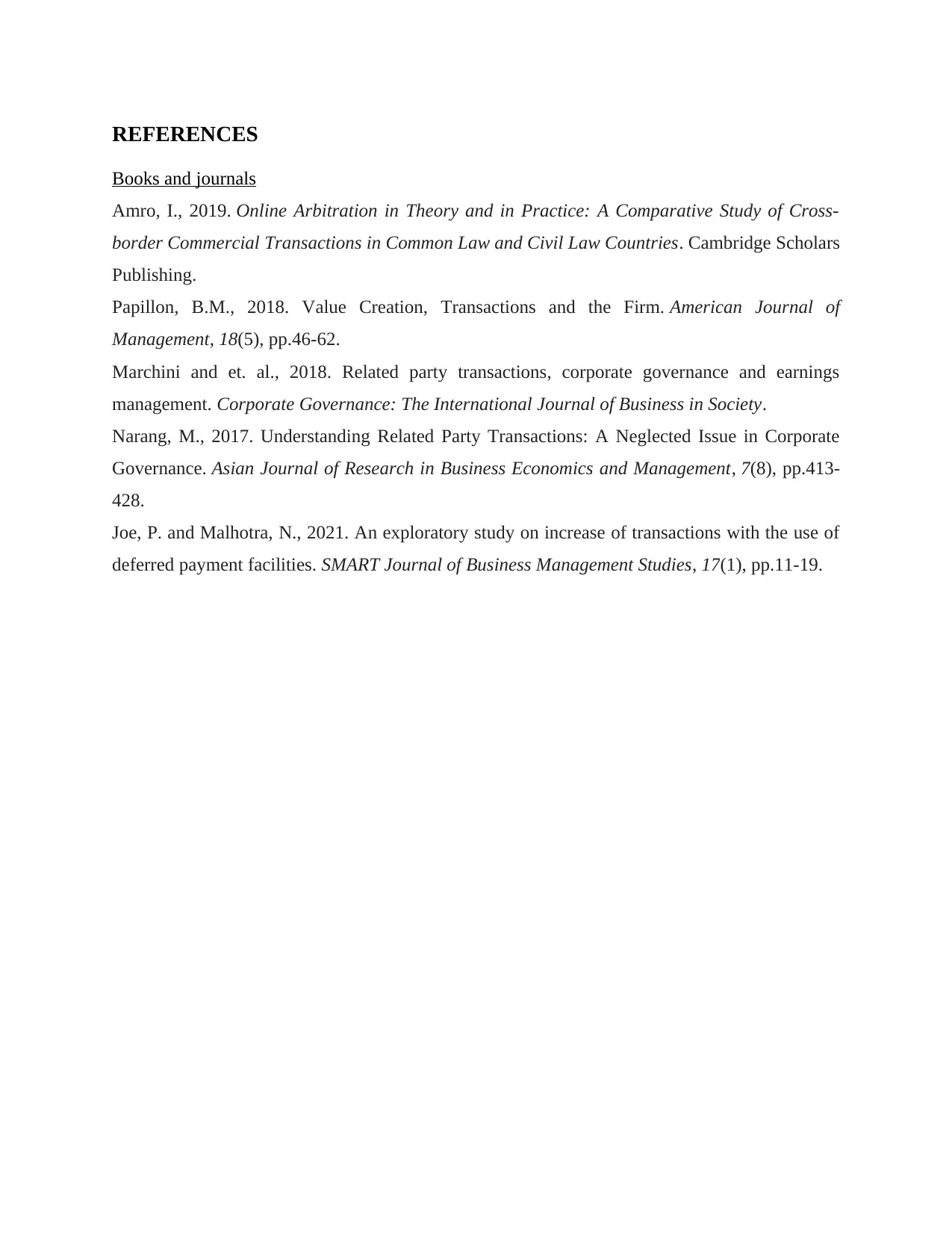
REFERENCES
Books and journals
Amro, I., 2019. Online Arbitration in Theory and in Practice: A Comparative Study of Cross-
border Commercial Transactions in Common Law and Civil Law Countries. Cambridge Scholars
Publishing.
Papillon, B.M., 2018. Value Creation, Transactions and the Firm. American Journal of
Management, 18(5), pp.46-62.
Marchini and et. al., 2018. Related party transactions, corporate governance and earnings
management. Corporate Governance: The International Journal of Business in Society.
Narang, M., 2017. Understanding Related Party Transactions: A Neglected Issue in Corporate
Governance. Asian Journal of Research in Business Economics and Management, 7(8), pp.413-
428.
Joe, P. and Malhotra, N., 2021. An exploratory study on increase of transactions with the use of
deferred payment facilities. SMART Journal of Business Management Studies, 17(1), pp.11-19.
Books and journals
Amro, I., 2019. Online Arbitration in Theory and in Practice: A Comparative Study of Cross-
border Commercial Transactions in Common Law and Civil Law Countries. Cambridge Scholars
Publishing.
Papillon, B.M., 2018. Value Creation, Transactions and the Firm. American Journal of
Management, 18(5), pp.46-62.
Marchini and et. al., 2018. Related party transactions, corporate governance and earnings
management. Corporate Governance: The International Journal of Business in Society.
Narang, M., 2017. Understanding Related Party Transactions: A Neglected Issue in Corporate
Governance. Asian Journal of Research in Business Economics and Management, 7(8), pp.413-
428.
Joe, P. and Malhotra, N., 2021. An exploratory study on increase of transactions with the use of
deferred payment facilities. SMART Journal of Business Management Studies, 17(1), pp.11-19.
1 out of 17
Related Documents
Your All-in-One AI-Powered Toolkit for Academic Success.
+13062052269
info@desklib.com
Available 24*7 on WhatsApp / Email
![[object Object]](/_next/static/media/star-bottom.7253800d.svg)
Unlock your academic potential
© 2024 | Zucol Services PVT LTD | All rights reserved.





